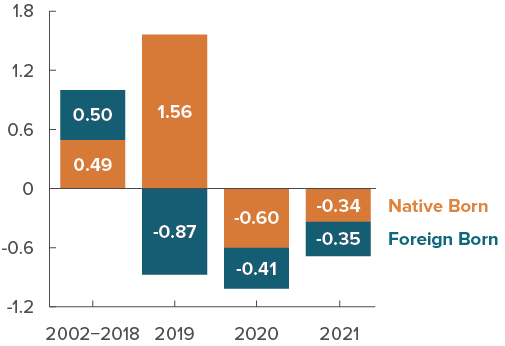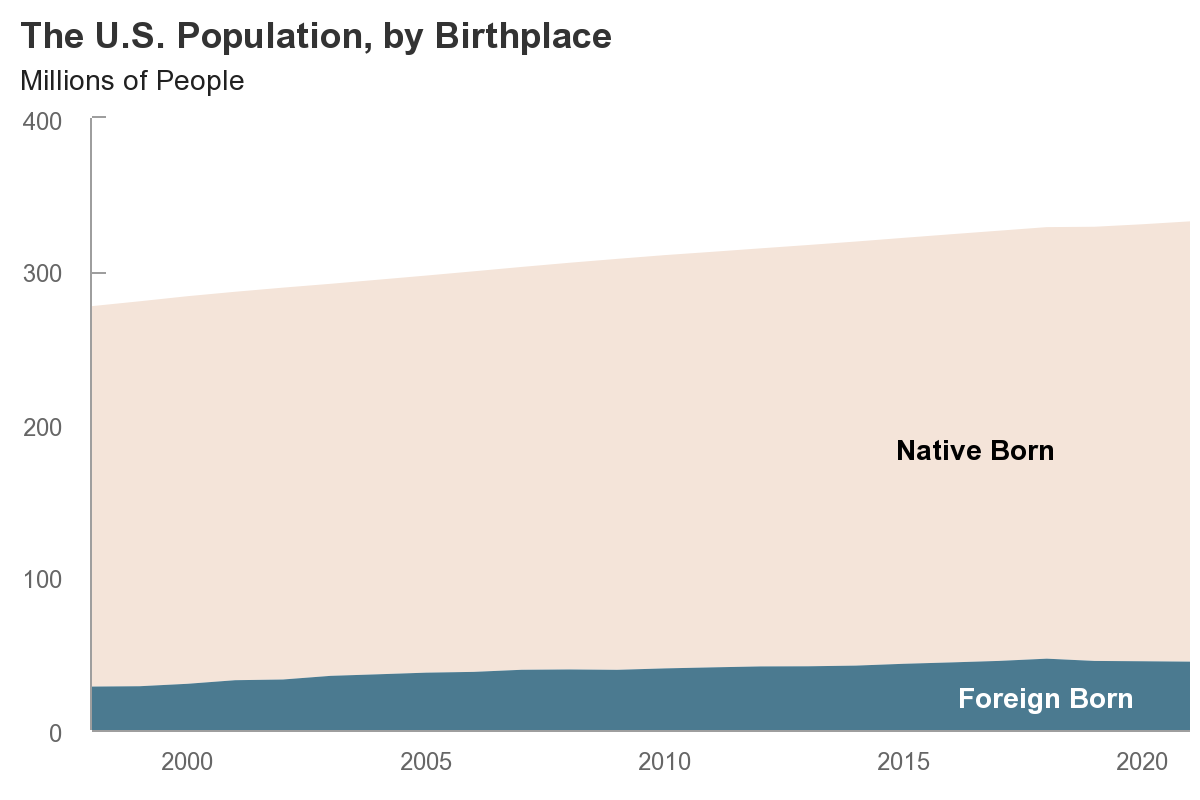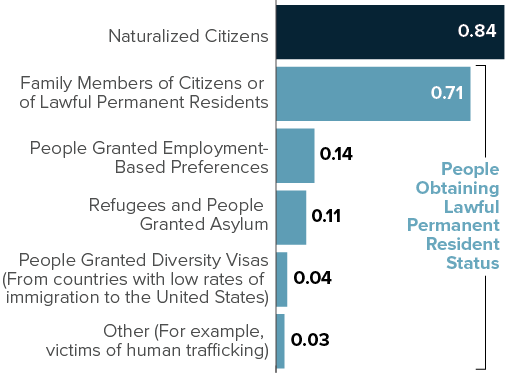An Overview of the Foreign-Born Population
About 45 million people living in the United States in 2021 were born in other countries. As of 2019, roughly three-quarters of the foreign-born population were here legally. That group includes naturalized citizens, lawful permanent residents, refugees, people who were granted asylum, and people who were temporarily admitted for a specific purpose, such as extended work or study. (People visiting the United States for business or pleasure are not included.) The remaining one-quarter were here illegally, having either remained here when their temporary legal status expired or crossed into the United States illegally. The decline in the foreign-born population between 2018 (when it numbered 47 million) and 2021 occurred largely because changes in immigration policy, some in response to the coronavirus pandemic, kept the number of immigrants below the number of foreign-born people leaving the country.
The Age Distribution of Native-Born and Foreign-Born People in the United States, 2021
Percent

The share of the foreign-born population that was 25 to 54 years old — the group with the highest rate of labor force participation — was greater than the corresponding share of the native-born population.
The Foreign-Born Population and the U.S. Economy
Immigration, whether legal or illegal, expands the labor force and changes its composition, increasing total economic output—although not necessarily output per person.
The effects of immigration on wages depend on immigrants’ skills. If newly arrived workers have skills that complement those of workers already in the United States, immigration will bolster productivity, having a positive effect on wages. If newly arrived workers have skills similar to those of workers already in the country, immigration will have a negative effect on those workers’ wages. Evidence suggests that the arrival of less-educated immigrants will probably have a small negative effect on the wages of less-educated workers already in the country and a larger negative effect on the wages of other immigrants who have recently arrived. Other forces, such as changes in technology and the global economy, also affect wages, so disentangling the influence of immigration on wages can be difficult.
People with legal immigration status are usually authorized to work, and people without legal immigration status are usually not authorized to work—although many do. (Section 208(d) of the Immigration and Nationality Act allows the Department of Homeland Security to provide employment authorization, subject to certain restrictions, to asylum applicants who are not otherwise eligible to work. The Administration, by rule, allows certain recipients of Deferred Action for Childhood Arrivals to receive employment authorization.) Granting legal status to people who are already in the United States without it would probably boost their wages and productivity. If those people acquired legal status, they would be better positioned to request higher pay and obtain jobs that match their skills.
The Average Annual Increase in the U.S. Labor Force, by Birthplace
Millions of People

Foreign-born people accounted for about half of the growth of the U.S. labor force between 2002 and 2018. In 2019, 2020, and 2021, the size of the foreign-born labor force dropped considerably because of changes in immigration policy and the pandemic.
The Share of Native-Born and Foreign-Born People Age 25 or Older in the United States, by Level of Education, 2021
Percent

Foreign-born people are most heavily represented in the population that does not have a high school diploma.
Occupations of Employed U.S. Workers Ages 25 to 54, by Birthplace, 2021
Percent

Relative to the native-born workforce, the foreign-born workforce is disproportionately concentrated in occupations with lower average wages.
The Foreign-Born Population and the Federal Budget
The effects that people have on the federal budget depend largely on the taxes that they pay and the government programs in which they participate. Foreign-born and native-born citizens are liable for the same taxes and are eligible for the same programs. Foreign-born people who are not citizens generally owe federal taxes, but their eligibility for various federal programs depends on their immigration status. (Similarly, people’s effects on state and local budgets depend on their liability for state and local taxes and their use of state and local public services.)
The Congressional Budget Office and the staff of the Joint Committee on Taxation (JCT) estimate the budgetary effects of proposed legislation that would affect immigration. In particular, they estimate the effects on revenues, spending for refundable tax credits, and federal benefit programs.
- When estimating the effects on revenues and refundable tax credits, CBO and JCT consider changes in foreign-born people’s legal status, authorization to work, possession of Social Security numbers, and likelihood of filing income tax returns.
- CBO and JCT typically do not estimate changes in revenues that would result from changes in the size of the foreign-born population—although they have done so when the legislation would substantially increase the U.S. population. That is because, following a practice established in the 1970s as part of the Congressional budget process, CBO and JCT generally assume that macroeconomic variables (such as gross domestic product and employment) would not change from the values that they are projected to reach under current law.
- When projecting changes in spending for federal benefit programs, CBO and JCT consider factors such as changes in the number of foreign-born people in the United States (and the number of their children born in the United States), the legal status of those people, and the likelihood that they would claim federal benefits.
Are Foreign-Born Noncitizens Liable for Income Taxes and Eligible for Tax Credits?
People’s liability for income taxes and eligibility for tax credits depend on whether they are lawful permanent residents—and if not, on how long they have been in the country, legally or illegally. CBO has not estimated the amount of federal taxes paid by people who are in the country illegally.

Are Foreign-Born Noncitizens Eligible for Benefits?
People with permanent legal status are almost always eligible for benefits through federal programs, although sometimes with a five-year delay. Eligibility is more limited for people with temporary legal status. Most people who are in the United States illegally are not eligible for benefits through federal programs. CBO has not estimated the amount of federal spending on people who are in the country illegally.

This document is part of the Congressional Budget Office’s continuing efforts to make its work transparent. In keeping with CBO’s mandate to provide objective, impartial analysis, the report makes no recommendations. For more information about the data, as well as details on immigrants’ federal tax liability and eligibility for federal programs, see www.cbo.gov/publication/58939.







